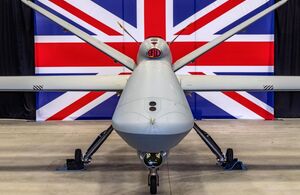New global surveillance aircraft begins UK trials
A new uncrewed RAF aircraft, capable of global surveillance operations, will begin trials in the UK this week.

Protector aircraft
-
The first of 16 Protector aircraft arrive at RAF Waddington for test flights
-
Boosts RAF technology with unparalleled surveillance and strike capability
-
Aircraft will undergo test flights until entering service in late 2024
The first of 16 remotely piloted Protector aircraft has arrived at RAF Waddington in Lincolnshire to commence a series of rigorous trials and tests before entering the RAF fleet.
Equipped with a suite of surveillance equipment, the Protector aircraft will bring a critical global surveillance capability for the UK, all while being remotely piloted from RAF Waddington.
It will be able to undertake a wide range of tasking including land and maritime surveillance to track threats, counter terrorism and support to UK civil authorities, such as assisting HM Coastguard with search and rescue missions.
With a wingspan of 79 feet, the uncrewed aircraft can operate at heights up to 40,000 feet and has an endurance of more than 30 hours, enabling unparalleled surveillance and strike capability.
The aircraft has been assembled by a newly reformed 31 Squadron who are preparing it for ground and air testing ahead of its anticipated in-service date later next year. 31 Sqn, which previously operated the Tornado GR4, will operate and maintain the aircraft at RAF Waddington. The squadron has a long history stretching back to 1915 and have operated multiple aircraft types in the last century. They are exclusively a Protector Sqn now and have been reformed to operate Protector as it enters Service.
Defence Procurement Minister, James Cartlidge MP said:
“The UK’s world-class Protector aircraft will emphasise our ultra-modern surveillance, intelligence, and precision strike capabilities, ensuring we are ready to monitor and protect against potential adversaries around the globe.
“With the first aircraft at RAF Waddington ready to begin trials, we will once again demonstrate how we are spearheading military defence technology.”
The first phase of tests, beginning this week, will involve ground testing of the satellite links and taxi procedures, as well as take-off and landing trials. This will also incorporate a circuit above RAF Waddington.
In addition to accepting the Intelligence, Surveillance, Target Acquisition and Reconnaissance (ISTAR) roles currently undertaken by Reaper, which has provided exceptional service on operations around the clock for more than 15 years, Protector will be certified to stringent NATO safety and certification standards allowing it to operate in the UK and European civilian airspace.
Senior Responsible Owner, Protector Programme Air Commodore Alex Hicks, said:
“The arrival of the UK’s first Protector to the Royal Air Force is the culmination of years of work by many personnel across the whole of the MOD. The ISR Capability Team will be working with 56 Sqn, our test and evaluation experts, who will put the aircraft through its paces to ensure it is ready for operational service next year, whilst the newly reformed 31 Sqn will focus on preparing to operate the aircraft in service. This is an important milestone for the Programme, Air Force and wider defence and I am delighted to see Protector at RAF Waddington.”
Head of Remotely Piloted Air System DE&S, Simon Holford said:
“The arrival of the first Protector system in the UK is a major milestone for the project. It reflects all of the hard work that everyone involved has put in to reach this stage, and we are immensely proud of our achievements. However, we can’t rest on our laurels as there is much more to do. Now assembled, this aircraft will be used to perform initial UK flight trials ahead of progressively delivering the capability to the RAF next year.”
Arrival of 15 further aircraft from General Atomics in the US into the UK will be a phased delivery over the coming years. All aircraft are expected to be delivered by the end of 2025.